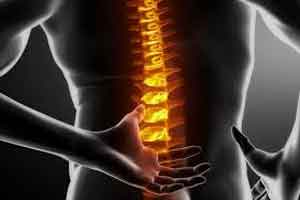- Home
- Editorial
- News
- Practice Guidelines
- Anesthesiology Guidelines
- Cancer Guidelines
- Cardiac Sciences Guidelines
- Critical Care Guidelines
- Dentistry Guidelines
- Dermatology Guidelines
- Diabetes and Endo Guidelines
- Diagnostics Guidelines
- ENT Guidelines
- Featured Practice Guidelines
- Gastroenterology Guidelines
- Geriatrics Guidelines
- Medicine Guidelines
- Nephrology Guidelines
- Neurosciences Guidelines
- Obs and Gynae Guidelines
- Ophthalmology Guidelines
- Orthopaedics Guidelines
- Paediatrics Guidelines
- Psychiatry Guidelines
- Pulmonology Guidelines
- Radiology Guidelines
- Surgery Guidelines
- Urology Guidelines
New recommendations for treating musculoskeletal pain

A new study led by The University of Western Australia has identified recommendations to effectively manage musculoskeletal problems. These recommendations will help health professionals and patients better manage musculoskeletal problems.
Musculoskeletal conditions - including back and neck pain, osteoarthritis and shoulder pain - affect nearly 7 million Australians with around one in five visits to the doctor due to a musculoskeletal pain condition. Musculoskeletal pain is very common and results in disability at a greater rate than any other condition.
The study, published in the British Journal of Sports Medicine examined clinical practice guidelines for musculoskeletal pain conditions.
Lead researcher Dr Ivan Lin from UWA’s Western Australian Centre for Rural Health said the challenge was understanding the best way to manage conditions which could be complex.
"It's important that patients are provided with information about the cause of their pain and what they can do to self-manage it. Although this may sound obvious in a lot of cases people do not manage their condition effectively due to lack of information and understanding," Dr Lin said.
"We also found imaging such as x-rays and scans are overused when they should really only be used selectively when there is a suspicion of a serious condition or the need for further investigation."
Dr Lin said it was also important for clinicians to assess patients’ emotions and beliefs about their condition which could have a big impact on recovery. "For example, if a person has the perception that their condition is caused by severe and permanent damage to a part of their body then they might over-protect it and avoid all physical activity which could worsen the problem."
UWA Clinical Associate Professor and specialist pain physician Dr Roger Goucke, also involved in the study, said the recommendations would improve outcomes for patients.
"If these recommendations are followed when patients first seek care, we will see less patients in trouble later on in the pain clinic," Dr Goucke said.
The study led by UWA researchers was also made possible by the work of researchers and clinicians from Curtin University, University of South Australia, University of Sydney, Harry Perkins Institute of Medical Research, Sir Charles Gardner Hospital, and Geraldton Hospital.
11 recommendations outlined in the study:
- Care should be patient-focused and involve the patient in decision making.
- Health professionals should screen for serious conditions such as fractures, cancer or conditions manifesting as musculoskeletal pain.
- Assessment of psychosocial factors should be part of treatment such as depression, anxiety or unhelpful beliefs about the pain that require special care.
- Radiological imaging should only be used when there is a suspicion of a serious condition.
- A physical examination should be used to assess physical capacity and if there are neurological problems.
- Professionals should monitor patient progress.
- Education and information should be provided to patients including a management plan for their condition.
- Advice should be provided to patients about what activity or exercise might help improve their condition.
- Manual therapies, such as joint manipulation or massage, should only be used in conjunction with treatments such as exercise, rather than on their own.
- High-quality non-surgical care, such as rehabilitation, should be administered prior to surgery.
- Patients should be encouraged to continue work if they are employed.

Disclaimer: This site is primarily intended for healthcare professionals. Any content/information on this website does not replace the advice of medical and/or health professionals and should not be construed as medical/diagnostic advice/endorsement or prescription. Use of this site is subject to our terms of use, privacy policy, advertisement policy. © 2020 Minerva Medical Treatment Pvt Ltd